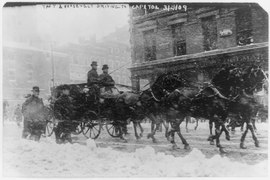 | |
| Date | March 4, 1909 |
|---|---|
| Location | United States Capitol, Washington, D.C. |
| Organized by | Joint Congressional Committee on Inaugural Ceremonies |
| Participants | William Howard Taft 27th president of the United States — Assuming office Melville Fuller Chief Justice of the United States — Administering oath James S. Sherman 27th vice president of the United States — Assuming office Charles W. Fairbanks 26th vice president of the United States — Administering oath |
| ||
|---|---|---|
27th President of the United States
Presidential campaigns
10th Chief Justice of the United States Post-presidency  | ||
The inauguration of William Howard Taft as the 27th president of the United States was held on Thursday, March 4, 1909, at the Senate chamber inside the United States Capitol, Washington, D.C., instead of the regular East Portico due to a blizzard. This was the 31st inauguration and marked the commencement of the only term of both William Howard Taft as president and of James S. Sherman as vice president.
Contents
As Sherman died 3 years, 240 days into this term, the office remained vacant for the balance: he was the last vice president to leave office intra-term prior to the ratification of the Twenty-fifth Amendment in 1967 (excluding Calvin Coolidge, Harry S. Truman and Lyndon B. Johnson, who ascended to the presidency after the deaths of their predecessors), which constitutionally allows for filling a vacancy in the office of vice president, and as of 2025, is also the most recent vice president to die in office.



